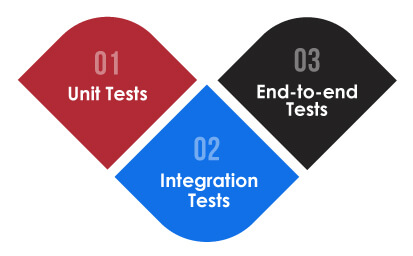
Table of Contents
- What is a Testing Pyramid?
- Why is Testing Pyramid Important for Agile Teams?
- Testing Pyramid Implementation Challenges
- Testing Pyramid Implementation Best Practices
- Summary
- Why Choose Tx for Quality Assurance Services?
Does your testing team have to wait long for their test suite to finish running? Do they have to re-execute test suites after failing continuously? If the answer is yes, then chances are their test suites do not fulfill testing pyramid criteria.
An efficient testing process is necessary in software development, especially under agile methodologies. Agile teams, known for their adaptability and speed, require testing methods to cope with development cycles. A testing pyramid is a strategic framework that allows agile teams to reshape the software QA approach. Also, the testing pyramid seamlessly integrates with continuous integration and delivery processes. It enhances the speed and reliability of the deployment process, necessary for agile teams to deliver high-quality software consistently.
What is a Testing Pyramid?
Testing or test automation pyramid is a framework to help developers and QA teams create high-quality software. Following a testing pyramid allows developers to minimize the time required to determine whether the new update affects their code. It also helps in creating robust test cases.
As the name suggests, the testing pyramid describes the test types that QA and development teams need to integrate in an automated test suite. It also defines the order and frequency of each test type. The main goal of the testing pyramid is to provide rapid feedback and ensure the new code changes don’t affect existing functionalities.

Levels of Test Automation Pyramid
Why is it necessary to distinguish between test types in the codebase? Let’s answer this question by breaking the test automation pyramid into different levels. It operates at three levels:
Unit Tests
These tests are the base of the testing pyramid. Unit testing ensures that the isolated code units perform as determined. These tests are responsible for assessing every single variable and do not rely on any dependencies (external). Unit tests are fast to execute and run consistently in the software development lifecycle. It allows developers and testers to identify and fix bugs early, thus maintaining high code quality standards.
Integration Tests
Integration test cases lie in the middle layer of the test automation pyramid, which is fewer in number compared to unit tests. The goal is to verify the integration between different parts or modules of the application. It includes integration with databases, external systems, APIs, etc. Although integration tests are complex and run slowly compared to unit tests, they are critical for ensuring software parts work in sync. QA teams execute these tests at key stages during the development cycle after implementing new features or updates.
End-to-end Tests
The top layer of the pyramid is the end-to-end test, which is very complex and has the longest execution time. It involves testing the entire application from start to finish based on the end user’s perspective. E2E testing includes evaluating UI, APIs, databases, etc. These tests are necessary to ensure the system works properly in real-world scenarios. This type of testing is sensitive and has unreliable external dependencies compared to integration tests.
Why is Testing Pyramid Important for Agile Teams?
Agile software development focuses on rapid and iterative progress. Maintaining the software quality is the main challenge in such a fast-paced environment. With the testing pyramid, Agile teams will get a comprehensive framework for effective software testing. It allows them to balance speed with quality, a key concern in SDLC. A testing pyramid is necessary to guide the agile teams in efficiently structuring testing processes. The importance of the testing pyramid in software development depends on a systematic approach to offer various benefits, such as:

Early Bug Detection
With unit testing as the foundation, the testing pyramid allows early detection of errors, bugs, or other vulnerabilities. QA teams must address such issues regularly and prevent them from escalating into bigger problems later. Early bug detection also maintains a high standard of code quality in the entire SDLC.
Cost-saving
The test automation pyramid approach is cost-efficient as it helps reduce the overall testing expenses by catching bugs early during unit testing. It is easy and cheaper to fix them early, which is beneficial for an Agile environment where resource allocation is critical.
Balanced Testing Strategy
The pyramid helps balance testing efforts across different levels – unit, integration, and E2E tests. It helps avoid over-reliance on one test type and ensures every aspect of the application is equally evaluated.
Improved QA process
A comprehensive coverage of test cases from the component level to the entire system helps elevate the QA process level. The pyramid ensures that every app component works as intended without skipping or compromising any step in the QA process.
Enhanced Speed and Agility
The testing pyramid works according to Agile principles of flexibility and speed. Gaining rapid feedback from unit tests, combined with integration and E2E testing, allows development teams to maintain a constant speed while maintaining software quality.
CI/CD Integration
The testing pyramid seamlessly integrates with CI and CD to make the QA process an integral and automated part of the SDLC. It supports the rapid development and deployment cycles in an Agile environment.
Testing Pyramid Implementation Challenges

Although the test automation pyramid is a powerful asset in Agile SDLC, the implementation process has some challenges. Understanding these obstacles is crucial for teams looking forward to effectively leveraging the pyramid. Let’s take a look at some of the testing pyramid implementation challenges:
• The first challenge is integrating unit, integration, and E2E tests effectively. Each level has a special approach requiring different tools, making integration a complex and time-consuming task.
• Achieving the right balance of tests at each pyramid level is difficult. Teams struggle to determine the required number of tests at each level, leading to inefficiencies.
• Allocating resources along with time and tools is complex. E2E tests are resource-intensive, sometimes overshadowing the frequent but less resource-heavy unit tests.
• Maintaining test case quality at each level is difficult. A poorly drafted test case could cause false positives. It decreases the effectiveness of the testing process.
• Agile projects are dynamic, as there are frequent changes and updates. Designing and adapting the test cases quickly to support these changes is challenging, especially for larger projects.
• Testing pyramid implementation requires certain technical expertise, especially when selecting and using varying testing tools. It becomes a barrier for teams with limited technical resources.
• Automating tests at the unit and integration levels is difficult due to the increase in complexity of maintaining the automated tests and ensuring their effectiveness in the long run.
• QA strategy requires continuous monitoring and updating to stay effective. It becomes resource-intensive and hampers other development activities.
Testing Pyramid Implementation Best Practices
Test automation pyramid implementation in Agile SDLC is a strategic step that requires following best practices to make it more effective. This ensures test cases are structured, aligned, and efficient with the project goals. Here are some practices that businesses should consider when implementing the testing pyramid in their development cycle:

• Develop robust unit test suites as they are the base of the test automation pyramid. Ask developers to write unit tests as they code, promoting a test-driven development approach.
• Integration tests must validate the sync between multiple components. Check whether these test cases cover every integration and can identify issues missed by unit tests.
• Plan to utilize service virtualization for the missing components in the test environment for integration testing.
• Plan E2E tests carefully as they are complex. Give extra attention to the user journey and important functionalities of the software. It will avoid over-testing and will save resources.
• Automate tests at unit and integration levels to enhance QA process efficiency and accuracy. Choose the right automation tools that align with the project technology stack and team skills.
• Regularly audit and review the test cases distributed across the pyramid. The number of simple and quick unit tests should be higher than complex E2E tests.
• Continuously evaluate and adapt the testing strategy to sync it with the rapid changes in the project scope and technology.
• Give a proper understanding of the purpose and structure of the testing pyramid to QA and development teams. It will support a collaborative environment where QA engineers, developers, and other stakeholders work together in the SDLC process.
• Invest time in drafting effective test cases to assess software functionality accurately without unnecessary code complexities.
• Regularly monitor the testing performance at each level. Optimize them for effectiveness and speed to add value to the development project without slowing it down.
Summary
The test automation pyramid is critical to the Agile software development process. It allows Agile teams to be efficient and deliver high-quality software. Testing pyramid is a transformative approach that restructures QA and aligns it with the Agile development environment. Early bug detection, cost-effectiveness, and a balanced testing strategy perfectly aligns with Agile methodology and ensures speed and adaptability. The pyramid’s integration with CI/CD processes is a crucial enabler for rapid and reliable software deployment. However, navigating its implementation comes with challenges that require careful planning, technical expertise, and continuous adaptation. By adhering to best practices, Agile teams can effectively overcome these challenges, unlocking the full potential of the testing pyramid.
Why Choose Tx for Quality Assurance Services?
The testing pyramid is a strategy that suggests the right balance of different types of tests (unit tests, integration tests, and UI/end-to-end tests) for effective and efficient quality assurance. Tx’s commitment to this approach ensures a comprehensive testing strategy that scales across various levels of the software development process. Renowned as a global leader in Digital Assurance and Quality Engineering, our extensive suite of QA services and broad industry expertise make us a reliable option for varying software testing requirements. Let’s look at why Tx is the top choice:

• We offer QA/test advisory and functional and non-functional testing tailored for next-gen technologies like AI, RPA, and IoT testing.
• Our process-oriented, proactive quality assurance and control strategy reflects the integration of testing pyramid principles.
• We have expertise serving various sectors, including healthcare, telecom, banking and finance, retail, and eCommerce.
• With offices and labs in multiple locations, we offer seamless and efficient services internationally.
• Featured in the Gartner® Market Guide and recognized as a NelsonHall’s NEAT Chart leader.
• We use our in-house accelerators to provide high-quality QA services.
• Our services cover everything from unit testing to complex E2E testing, echoing the testing pyramid approach and ensuring comprehensive support throughout the development cycle.
Discover more
Get in Touch
Stay Updated
Subscribe for more info




